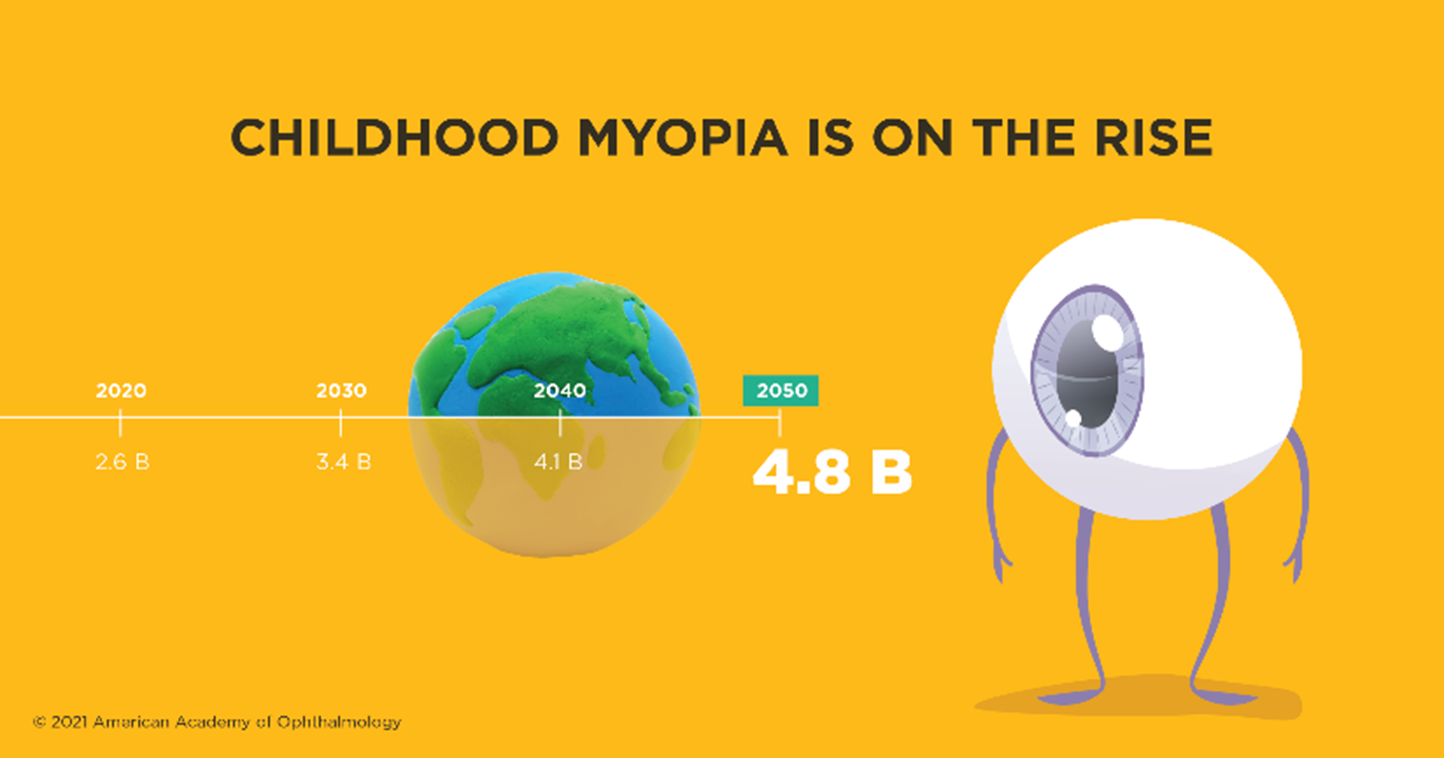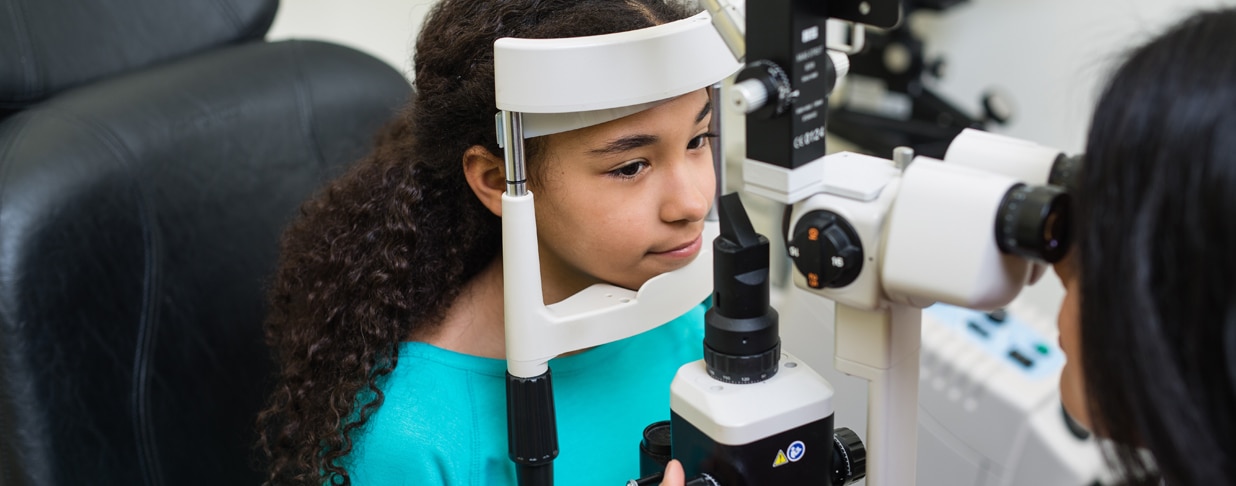Myopia is on the rise with no signs of slowing – making it the biggest threat to eye health of the 21st century.1 Currently 40% of Americans are myopic.2 And the American Optometric Association predicts that 52% of the world population could be impacted by the disease by the year 2050.3 The good news is that with proactive care, a customized benefits plan and regular vision care exams – myopia is manageable.
Through the lens of a myopia patient
Myopia, also known as nearsightedness, is an eye condition where close-up objects appear clear but distant objects appear as blurry. For example, a myopia patient may be able to read a map with ease but have difficulty seeing a road sign.4
Myopia develops when a person’s eye grows too long from front to back. The oblong shape keeps eyes from focusing correctly when light rays enter. In turn, the rays fall short of the retina. Myopia can also be caused by an overly curved cornea. The outcome from either anomaly is blurred vision.5
Seeing the signs: why early detection is key6
Nearsightedness develops most often in childhood between the ages of 6 and 14. Children have an increased likeliness of developing myopia if their parents are nearsighted.5 Each parent with myopia triples their child’s risk of developing the same condition. And if both parents are nearsighted, you’re looking at double trouble – a 6x higher risk of myopia being passed on to children genetically.6
Signs of myopia to look out for7
- Myopia patients frequently complain of headaches, eyestrain and tiredness
- Children may be seen squinting, blinking, rubbing their eyes, holding objects close to their faces or getting frustrated because they can't see the TV or a whiteboard at school
- Adults often have difficulty seeing a movie or driving, especially at night
Myopia numbers continue to rise4
The exact cause of myopia is unknown; however, it is thought to be a mix of genetics and environmental factors. The most recent upswing appears to be driven by close-up activities such as reading and digital screen time.8
With the massive increase in screen time due to the pandemic lifestyle, it is no surprise that nearly 5 billion people are predicted to have myopia by 2050.3 Providing access to vision benefits and annual vision care exams is the best strategy for protecting employee health and your workforce.
Empowering employees to protect their eye health
Glasses help improve blurry vision, but they don’t stop deterioration of the eye itself. While some treatments can slow the progression – such as Essilor® Stellest lenses – there is no current cure for the disease. It is critical for employees to receive regular vision care to prevent progression of serious eye conditions that can develop later in life such as cataracts, detached retinas and glaucoma– all common with high myopia.2 Defined as nearsightedness with a refractive error greater than -6, if left untreated, high myopia can ultimately lead to complete vision loss. 2
An annual eye exam is important starting at age 5 to drive proactive behavior.9 And EyeMed is here to help make adapting routine vision care easy for your employees. That’s why we remove the barriers of eye exams with Eye360 and send exam reminders and high-risk mailers through HealthyEyes.
- Eye360* – enhanced benefits when members visit a PLUS Provider, including $0 copay on an eye exam and up to $50 additional frame allowance
- EyeRewards – members earn rewards for getting an eye exam, win special prizes and pick up wellness tips, all while learning healthy behaviors and racking up savings at retailers
- HealthyEyes – proactive wellness messaging to employees throughout the year with education and resources that can help reduce the impact of serious health conditions
For more information on how EyeMed makes it easy for you and your employees to get ahead of the myopia epidemic, visit eyemed.com.
••••
*Fully insured plans underwritten by Fidelity Security Life Insurance Company ®, Kansas City, MO. See policy for covered benefits and exclusions. Not available in all states.
1 – Johnson & Johnson, “Managing Myopia: A Clinical Response to the Growing Epidemic,” December 2020.
2 – Cleveland Clinic, "Myopia (Nearsightedness),” July 2020.
3 – American Optometric Association, “Reshaping care: New myopia management guidance released," January 2021.
4 – American Academy of Ophthalmology, “Nearsightedness: What is Myopia?” December 2021.
5 – American Academy of Pediatrics, “Myopia (Nearsightedness) in Children & Teens,” May, 2022.
6 – All About Vision, “Myopia (nearsightedness): Causes, progression and management,” April 2022.
7 – Mayo Clinic, “Nearsightedness," April 2020.
8 – All About Vision, “Why myopia progression is a concern,” March 2022.
9 – SightMD, “How Often Should My Child Have Eye Exams?” January 2022.

Myopia develops when a person’s eye grows too long from front to back. The oblong shape keeps eyes from focusing correctly when light rays enter. In turn, the rays fall short of the retina. Myopia can also be caused by an overly curved cornea. The outcome from either anomaly is blurred vision.5
Seeing the signs: why early detection is key6
Nearsightedness develops most often in childhood between the ages of 6 and 14. Children have an increased likeliness of developing myopia if their parents are nearsighted.5 Each parent with myopia triples their child’s risk of developing the same condition. And if both parents are nearsighted, you’re looking at double trouble – a 6x higher risk of myopia being passed on to children genetically.6
Signs of myopia to look out for7
- Myopia patients frequently complain of headaches, eyestrain and tiredness
- Children may be seen squinting, blinking, rubbing their eyes, holding objects close to their faces or getting frustrated because they can't see the TV or a whiteboard at school
- Adults often have difficulty seeing a movie or driving, especially at night
Myopia numbers continue to rise4
The exact cause of myopia is unknown; however, it is thought to be a mix of genetics and environmental factors. The most recent upswing appears to be driven by close-up activities such as reading and digital screen time.8

With the massive increase in screen time due to the pandemic lifestyle, it is no surprise that nearly 5 billion people are predicted to have myopia by 2050.3 Providing access to vision benefits and annual vision care exams is the best strategy for protecting employee health and your workforce.
Empowering employees to protect their eye health
Glasses help improve blurry vision, but they don’t stop deterioration of the eye itself. While some treatments can slow the progression – such as Essilor® Stellest lenses – there is no current cure for the disease. It is critical for employees to receive regular vision care to prevent progression of serious eye conditions that can develop later in life such as cataracts, detached retinas and glaucoma– all common with high myopia.2 Defined as nearsightedness with a refractive error greater than -6, if left untreated, high myopia can ultimately lead to complete vision loss. 2
An annual eye exam is important starting at age 5 to drive proactive behavior.9 And EyeMed is here to help make adapting routine vision care easy for your employees. That’s why we remove the barriers of eye exams with Eye360 and send exam reminders and high-risk mailers through HealthyEyes.
- Eye360* – enhanced benefits when members visit a PLUS Provider, including $0 copay on an eye exam and up to $50 additional frame allowance
- EyeRewards – members earn rewards for getting an eye exam, win special prizes and pick up wellness tips, all while learning healthy behaviors and racking up savings at retailers
- HealthyEyes – proactive wellness messaging to employees throughout the year with education and resources that can help reduce the impact of serious health conditions
For more information on how EyeMed makes it easy for you and your employees to get ahead of the myopia epidemic, visit eyemed.com.
••••
*Fully insured plans underwritten by Fidelity Security Life Insurance Company ®, Kansas City, MO. See policy for covered benefits and exclusions. Not available in all states.
1 – Johnson & Johnson, “Managing Myopia: A Clinical Response to the Growing Epidemic,” December 2020.
2 – Cleveland Clinic, "Myopia (Nearsightedness),” July 2020.
3 – American Optometric Association, “Reshaping care: New myopia management guidance released," January 2021.
4 – American Academy of Ophthalmology, “Nearsightedness: What is Myopia?” December 2021.
5 – American Academy of Pediatrics, “Myopia (Nearsightedness) in Children & Teens,” May, 2022.
6 – All About Vision, “Myopia (nearsightedness): Causes, progression and management,” April 2022.
7 – Mayo Clinic, “Nearsightedness," April 2020.
8 – All About Vision, “Why myopia progression is a concern,” March 2022.
9 – SightMD, “How Often Should My Child Have Eye Exams?” January 2022.



